SOURCE ::https://twitter.com/hashtag/OROPSocialMediaTeam?src=hash
OROP ::#MumbaiOROPRally
- OROP AT MUMBAI
- This is the City of Dreams, where too much is never enough. Book your spot: http://bit.ly/1NkpoZf
 22 retweets28 favorites
22 retweets28 favorites
- Sanjay Mishra Retweeted@ColSanjayPande Retweeted One Rank One Pension@ColSanjayPande added,
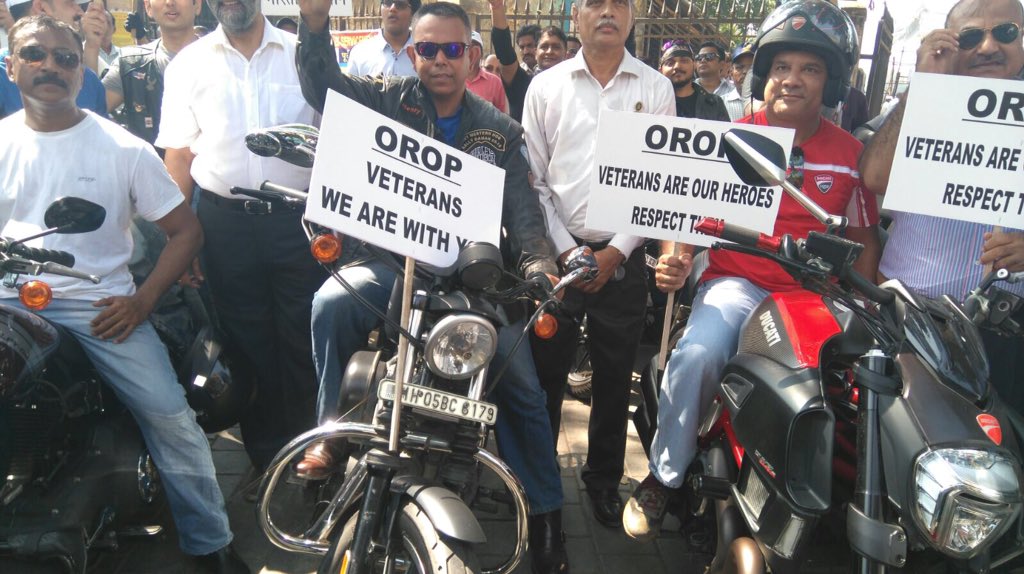

 One Rank One Pension @MissionOROP
One Rank One Pension @MissionOROP
#MumbaiOROPRally #OROP Bikers at Azad Maidan. Legendary biker, Col Sohan Roy a Guinness Book Record holder9 retweets5 favorites
- Col NR Kurup and 1 other Retweeted
- Umong Sethi favorited"Mumbai live" massive support for our veteran soldiers . Keep it rolling Mumbai #OROP #MumbaiOROPRally

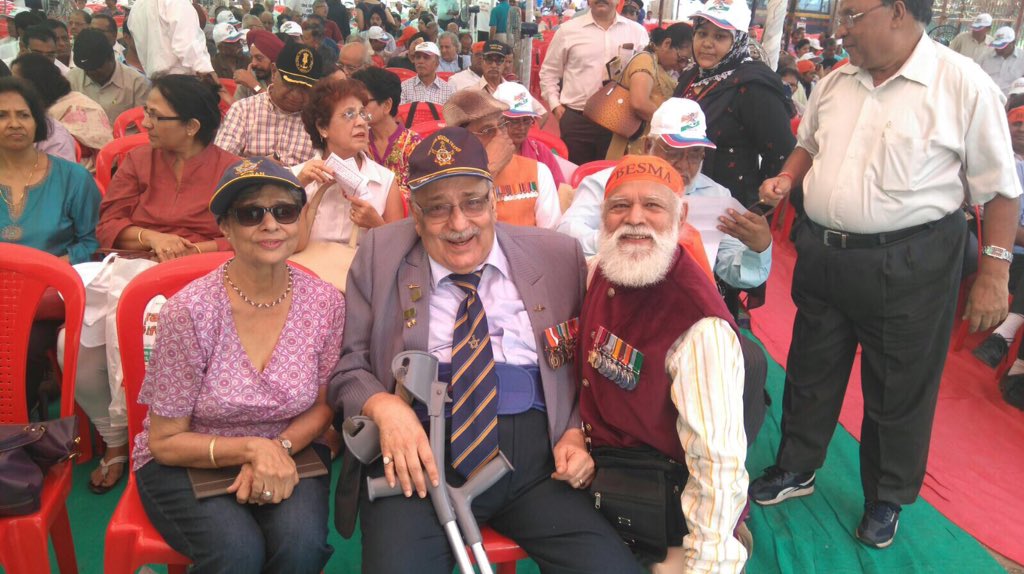
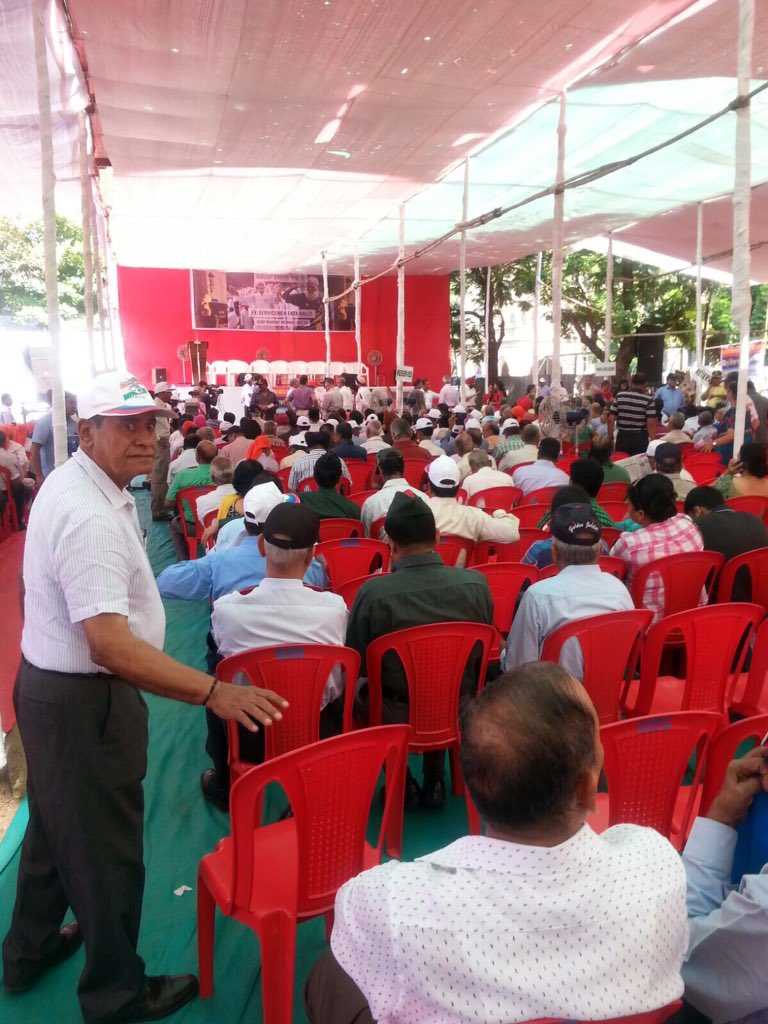
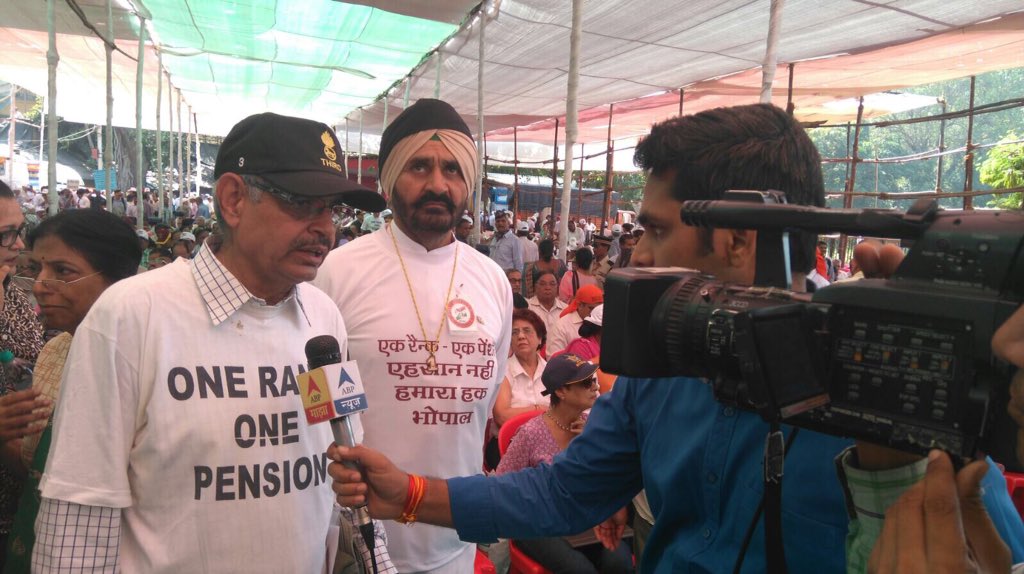 11 retweets3 favorites
11 retweets3 favorites
- One Rank One Pension and 7 others followPriyadarshi Retweeted Jo#OROP #MumbaiOROPRally @PraveshRenjen @ColSanjayPande @JoBeingjoe Way to go the heavy mortars (60 Heavy). BLAST THEMPriyadarshi added,9 retweets1 favorite
- amitabha amitabha, and 1 other Retweeted
 15 retweets10 favorites
15 retweets10 favorites
PhotosView all
 Image gallery thumbnail
Image gallery thumbnail
 Image gallery thumbnail
Image gallery thumbnail
 Image gallery thumbnail
Image gallery thumbnail Image gallery thumbnail
Image gallery thumbnail- Mrs Garware, daughter of an Army Officer donates Rs 5 lacs. Fund flow unabated since last 139 days.#MumbaiOROPRally
 49 retweets24 favorites
49 retweets24 favorites
- @ColSanjayPande Retweeted Jo#MumbaiOROPRally #OROP Wonderful reporting Joe.@ColSanjayPande added,
Jo @JoBeingjoe
#MumbaiOROPRally #OROP Iam at Azad Maidan to support Indian Armed Forces Veterans. Are you?6 retweets4 favorites
- Fauji Magazine and 8 others follow
 22 retweets8 favorites
22 retweets8 favorites
- Priyadarshi Retweeted Jo#OROP #MumbaiOROPRally Bikers, across India, as a fraternity ride in solidarity with the veterans. God Bless!Priyadarshi added,10 retweets3 favorites
- baldev pandher and 1 other Retweeted#MumbaiOROPRally I am informed that the strength is much much more than originally thought of. Speaks of a "just" cause.15 retweets6 favorites
- Pravesh Renjen Retweeted One Rank One Pension#MumbaiOROPRally Overwhelmed to see the response.Pravesh Renjen added,

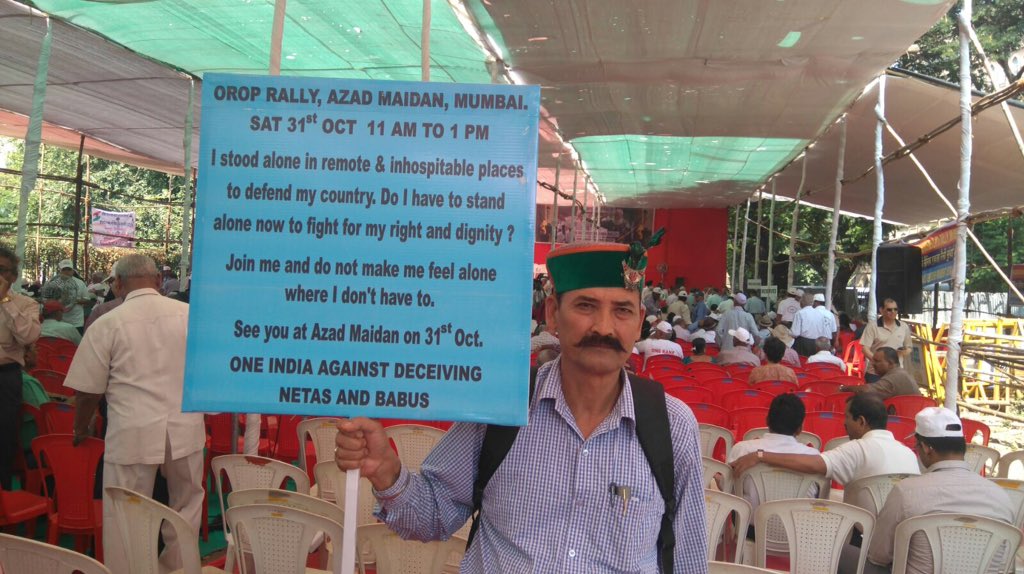
 One Rank One Pension @MissionOROP
One Rank One Pension @MissionOROP
#MumbaiOROPRally #OROP Col Pushpendra , Hav Major Singh at Rally site.5 retweets3 favorites
- One Rank One Pension and 13 others follow#MumbaiOROPRally Looking forward to meeting ex servicemen of Maharashtra. It has large ESM population and will be briefed on #OROP9 retweets6 favorites
- #OROP @PMOIndia #MumbaiOROPRally This is the Tribute of our Defense Services to the Nation for its Unity & Integrity
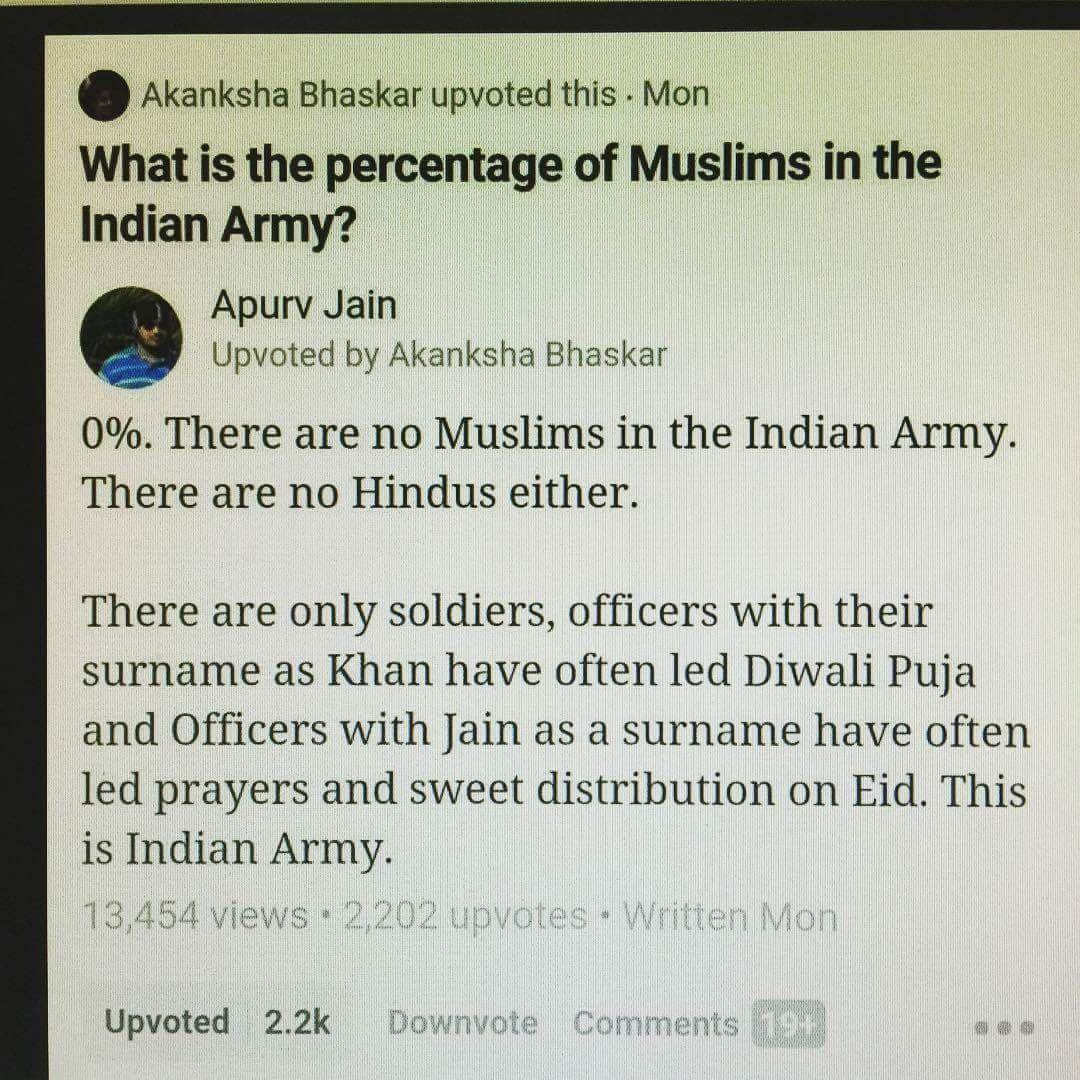 6 retweets4 favorites
6 retweets4 favorites
- #OROP @PMOIndia #MumbaiOROPRally What about a White Paper on OROP?U demanded 1from UPA Govt?The Nation wants2 know
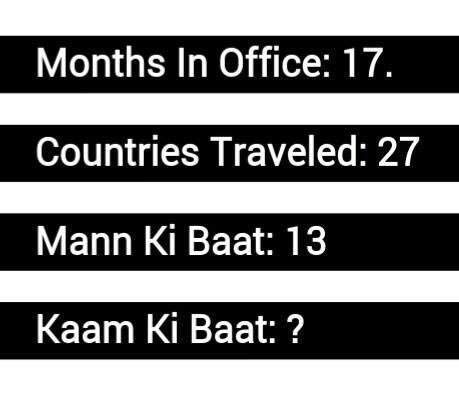 8 retweets5 favorites
8 retweets5 favorites
- Mumbaikars,Today is the day to showcase your support for your soldiers.Come and join in big numbers #MumbaiOROPRally
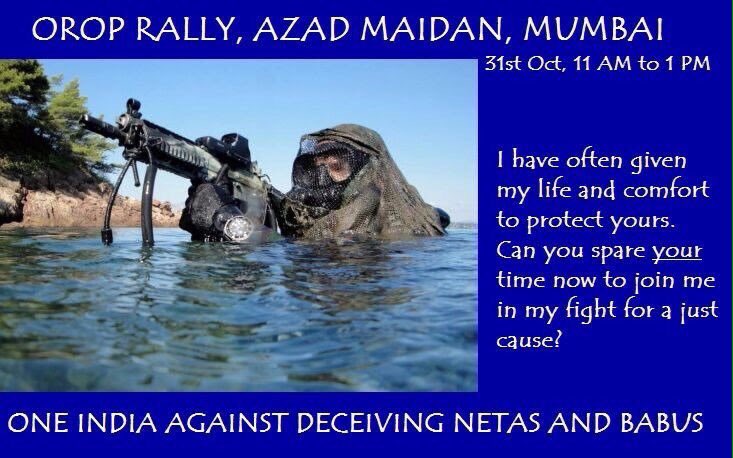 17 retweets9 favorites
17 retweets9 favorites
- #MumbaiOROPRally if govt is so serious, why no discussion with veterans n assurance that 7 anomalies removed?@simba49 @BringOROP #OROP10 retweets4 favorites
- NAV€€N Retweeted#OROP #MumbaiOROPRally @PMO Who will you, now, demand the 'white paper' from? Patience is wearing thin. Beware!12 retweets4 favorites
- #MumbaiOROPRally #OROP Tomorrow is 139th Day of Relay of Hunger Strike at JantarMantar. I will be at AzadMaidan Mumbai. Govt- Any surprises?71 retweets29 favorites
- #MumbaiOROPRally #OROP I have advised Govt in past to be absolutely transparent before issuing notification. Why secrecy?21 retweets4 favorites
- baldev pandher RetweetedPriyadarshi Retweeted One Rank One Pension#OROP #MumbaiOROPRally Mumbaikars, awake and be there at Azad Maidan, my countrymen.Priyadarshi added,
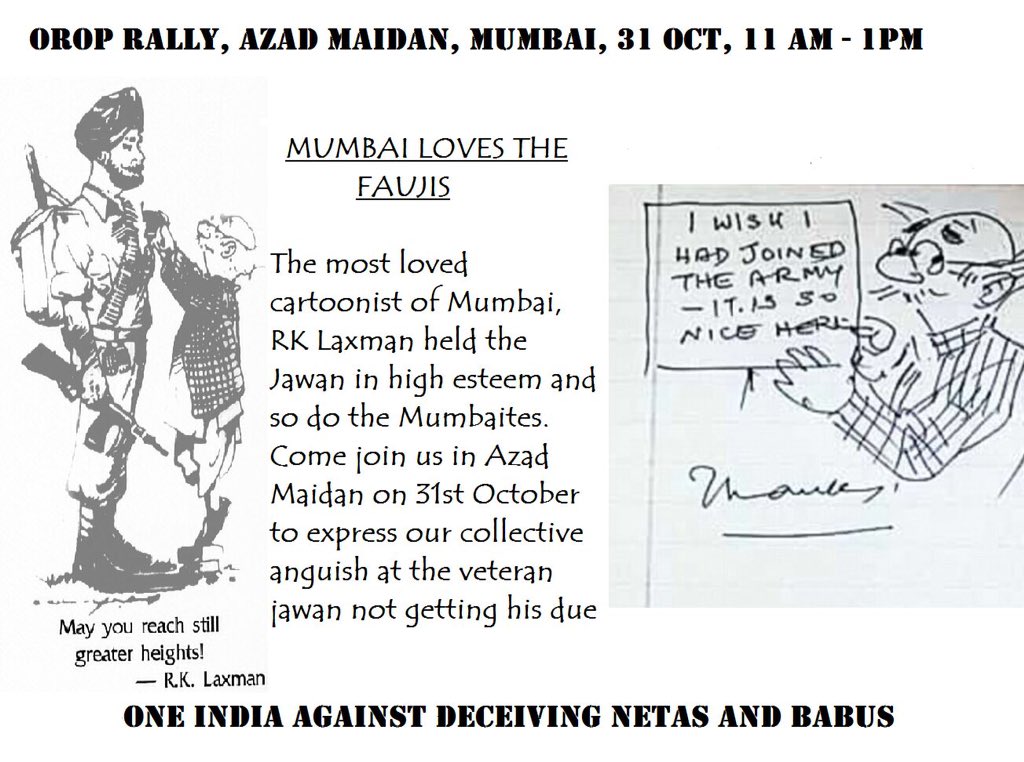

 One Rank One Pension @MissionOROP
One Rank One Pension @MissionOROP
#MumbaiOROPRally #OROP Everyone is invited at Azad Maidan Mumbai at 11 am tomorrow. WE WILL BE THERE.14 retweets3 favorites
- Sanjay Mishra and 1 other Retweeted#MumbaiOROPRally #OROP Every pan India Rally sends a direct message to India and World- resolve gets stronger each passing day.29 retweets8 favorites
- One Rank One Pension and 13 others follow#MumbaiOROPRally #OROP Tomorrow is 139th Day of Relay Hunger Strike at JantarMantar and I will be at AzadMaidan Mumbai. Govt- Any surprises?19 retweets7 favorites
- One Rank One Pension and 7 others follow#OROP #MumbaiOROPRally @PMOIndia @narendramodi A gentle reminder of your promise. Don't let it become another jumla13 retweets4 favorites
- preetiranjan raut and 2 others Retweeted#MumbaiOROPRally #OROP What instructions has Govt passed to handle Mumbai Rally? Blackout Media? Spread Rumours? Use force? Can do anything.34 retweets9 favorites
- Veterans deserve better. Support them to the fullest. Mumbai rally tomorrow. #OROP #MumbaiOROPRally3 retweets2 favorites
- Mahatma Gandhi followsInfidel Castro Retweeted JoThey gave their present for your future. Give your time to them now. #OROP #MumbaiOROPRallyInfidel Castro added,
Jo @JoBeingjoe
Come in support of Veterans who gave up their today for our tomorrow. #MumbaiOROPRally #OROP @MissionOROP https://twitter.com/vikramwkarve/status/659978474375876608 …19 retweets6 favorites
- Fauji Magazine and 8 others followJo Retweeted One Rank One PensionNot one minister has visited Jantar Mantar. #MumbaiOROPRally #OROP Azad Maidan Oct 31 11am. Pls support veterans.Jo added,
0:27 One Rank One Pension @MissionOROP
One Rank One Pension @MissionOROP
#OROP #MumbaiOROPRally #OROPSocialMediaTeam 24 Months back..."MIL BAITH KAR RAASTA NIKALTE" #OROPWalkTheTalk19 retweets6 favorites
- Infidel Castro Retweeted JoWhat the true Orop is and what the govt is delivering. #MumbaiOROPRally #OROPInfidel Castro added,
Jo @JoBeingjoe
#MumbaiOROPRally #OROP What was promised and what is delivered. https://m.facebook.com/groups/1635990913309822?view=permalink&id=1640225022886411 … @Ritvik92 @MissionOROP10 retweets1 favorite
- Sec 144 or not all those attending or prevented please tweet your experience/ impressions tomorrow. Pl also post in fb. #mumbaioroprally5 retweets0 favorites
- #OROPSocialMediaTeam #OROP #MumbaiOROPRally SIGN ON LINE PETITION. All Indians. Your ForcesYourVeterans https://www.change.org/p/prime-minister-of-india-one-rank-one-pension-veterans-of-india-are-suffering?recruiter=362684276&utm_source=share_petition&utm_medium=copylink …5 retweets2 favorites
- #MumbaiOROPRally Section 144 promulgated in Mumbai. We are informed that OROP Rally in Azad Maidan on 31 Oct at 11 am has not influenced it.35 retweets14 favorites
- #MumbaiOROPRally on 31 Oct at Azad Maidan at 11 am will demonstrate the resolve of veterans to bring forth the continued apathy of Govt.29 retweets10 favorites
- Jo Retweeted Inderpreet KaurPls come in support of our veterans #MumbaiOROPRally #BombayJo added,5 retweets1 favorite
- Yo Mumbaikars! Here's your chance to support your military veterans. Attend #MumbaiOROPRally on 31 Oct. Pl RT and help spread the word.29 retweets9 favorites
- "Mumbai Chalo" Azad maidan on 31st October.I stand with my soldier,are you going to be there ?#MumbaiOROPRally #OROP
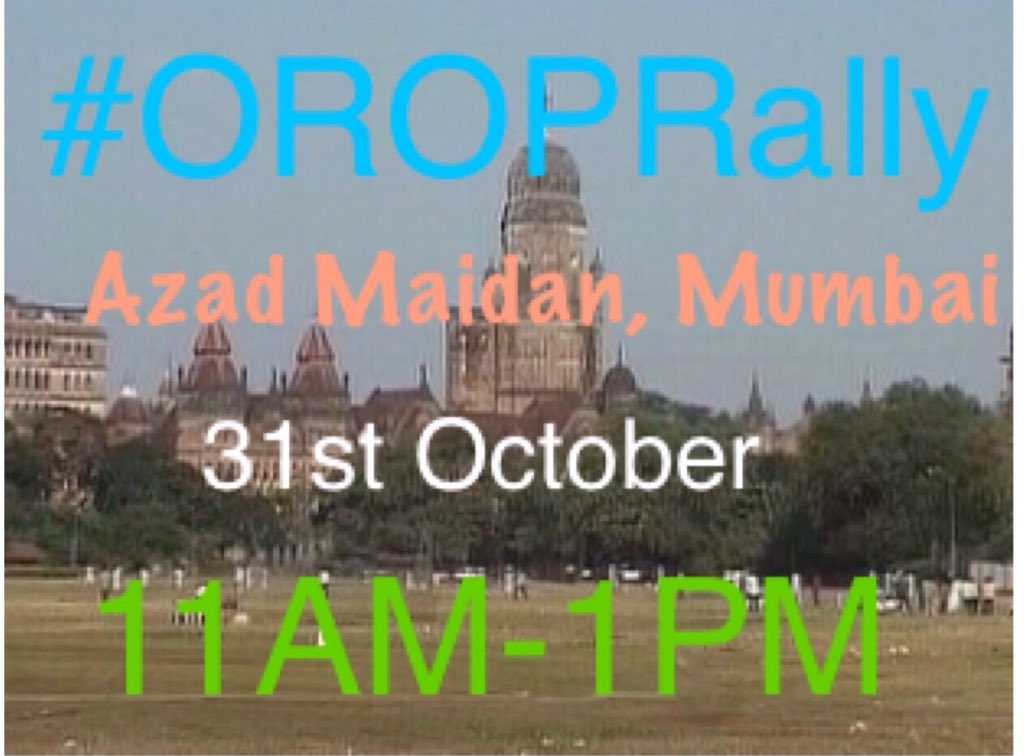
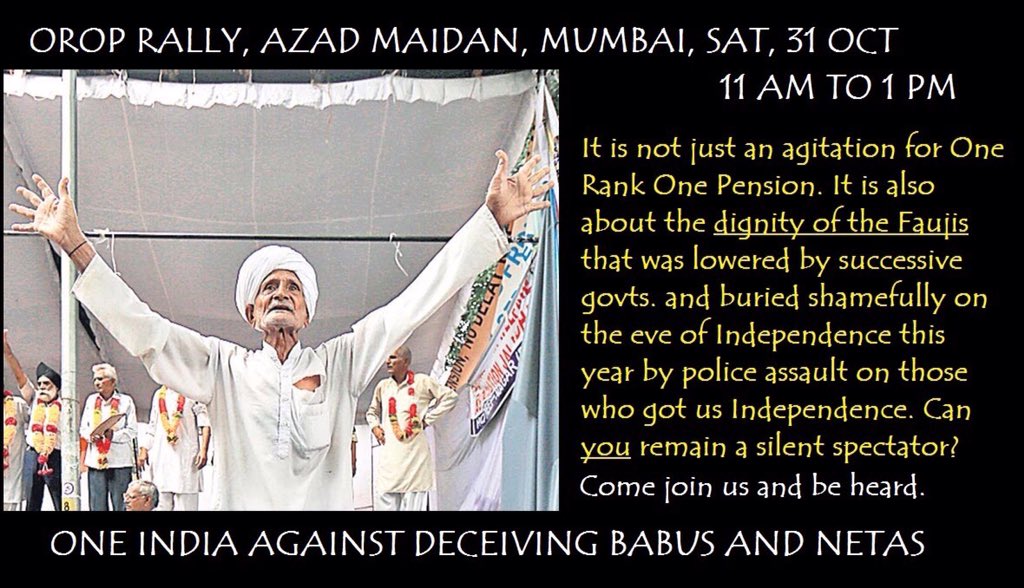 14 retweets3 favorites
14 retweets3 favorites
- @MissionOROP #MumbaiOROPRally before elections..bhaiyo #OROP is my top priority after elections.. Not showing face to vetrans8 retweets1 favorite
- S Arun Retweeted Col Dinesh Kumar(R)#MumbaiOROPrally AmenS Arun added,
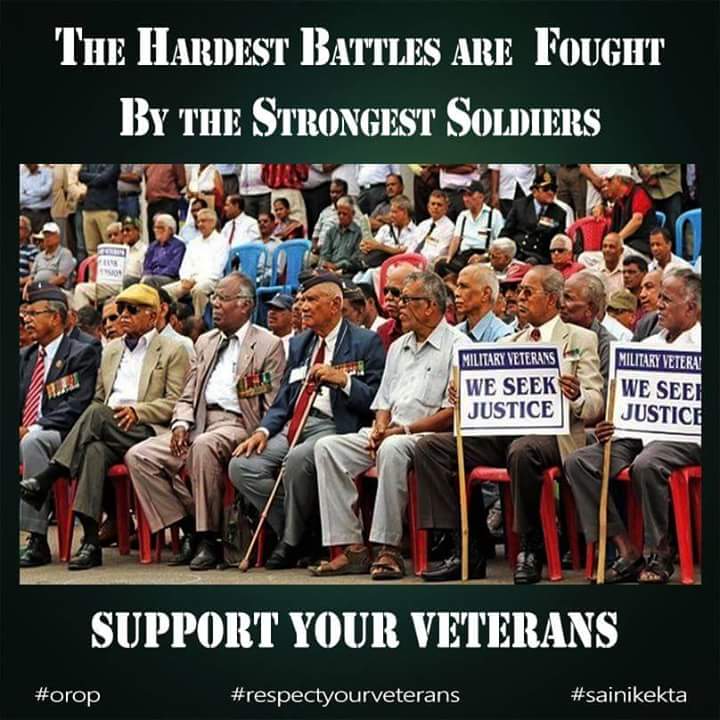 Col Dinesh Kumar(R) @kkhushal9
Col Dinesh Kumar(R) @kkhushal9
#OROPrally hi all well wishers, We expect you at Azad maidan on 31 Oct to make our rally a memorable one.3 retweets1 favorite
- @gen_arun @MissionOROP @mehrotrar50 Yes! Please use #MumbaiOROPRally in all your tweets. This is the official hashtag till the 31st
- Fauji Magazine and 8 others followJo Retweeted Jennifer☮FernandesJo added,
 Jennifer☮Fernandes @nandtara
Jennifer☮Fernandes @nandtara
This #93YearOldAdmiral will live to fight another day to stay alive for his #OROP @manoharparrikar please note 3/32 retweets0 favorites
- amitabha amitabha, Retweeted
 16 retweets5 favorites
16 retweets5 favorites
- baldev pandher RetweetedPrashant Sethi Retweeted One Rank One PensionPlease spread the word #mumbaiOropRally ... show solidarity to the ones who have protected you. Rt ...@anilkapur_Prashant Sethi added,
One Rank One Pension @MissionOROP
#OROPSocialMediaTeam Appeal to everyone.Use Hashtag " #MumbaiOROPRally "only. Massive social media team deployed in Mumbai. #VeteransOfIndia12 retweets3 favorites
- Prakash Katoch and 2 others followAshwas Priyadarshan Retweeted One Rank One PensionHope mny civilians will join our veterans. Mumbaikars let's stand together fr our defenders!! #MumbaiOROPRally #OROPAshwas Priyadarshan added,
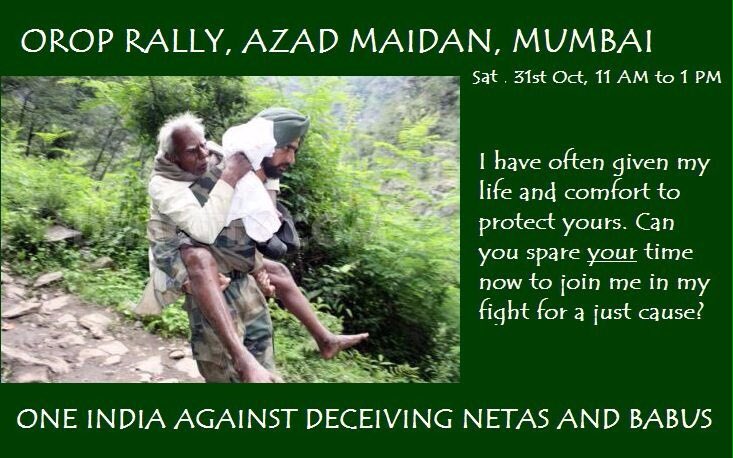
 One Rank One Pension @MissionOROP
One Rank One Pension @MissionOROP
#MumbaiOROPRally #OROP #OROPSocialMediaTeam Get ready for a massive show at Mumbai on 31 Oct. #VeteransOfIndia3 retweets1 favorite
- preetiranjan raut and 1 other Retweeted#OROPSocialMediaTeam Appeal to everyone.Use Hashtag " #MumbaiOROPRally "only. Massive social media team deployed in Mumbai. #VeteransOfIndia56 retweets16 favorites
- Sanjay Mishra and 1 other Retweeted#MumbaiOROPRally AZAD MAIDAN, 31 OCT, 11AM. #OROP Understand why veterans are on road. जिस देश का सैनिक सडकों पर, उस देश का दुर्भाग्य है70 retweets16 favorites
- One Rank One Pension and 3 others Retweeted#MumbaiOROPRally #OROP #OROPSocialMediaTeam Get ready for a massive show at Mumbai on 31 Oct. #VeteransOfIndia

 87 retweets13 favorites
87 retweets13 favorites

 Mumbai City FC
Mumbai City FC @ColSanjayPande
@ColSanjayPande  One Rank One Pension
One Rank One Pension 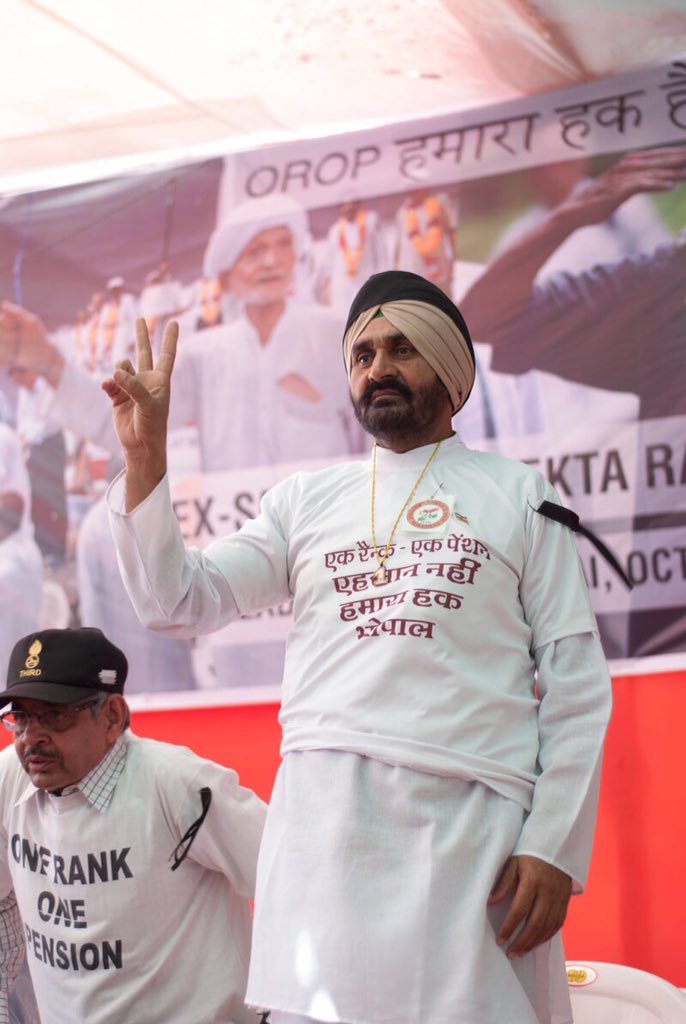
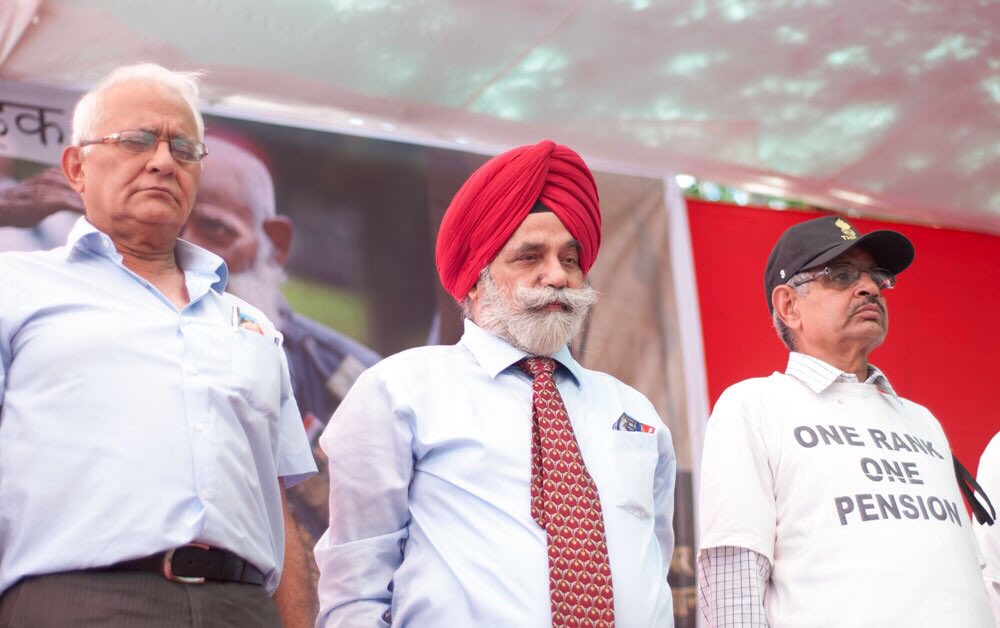
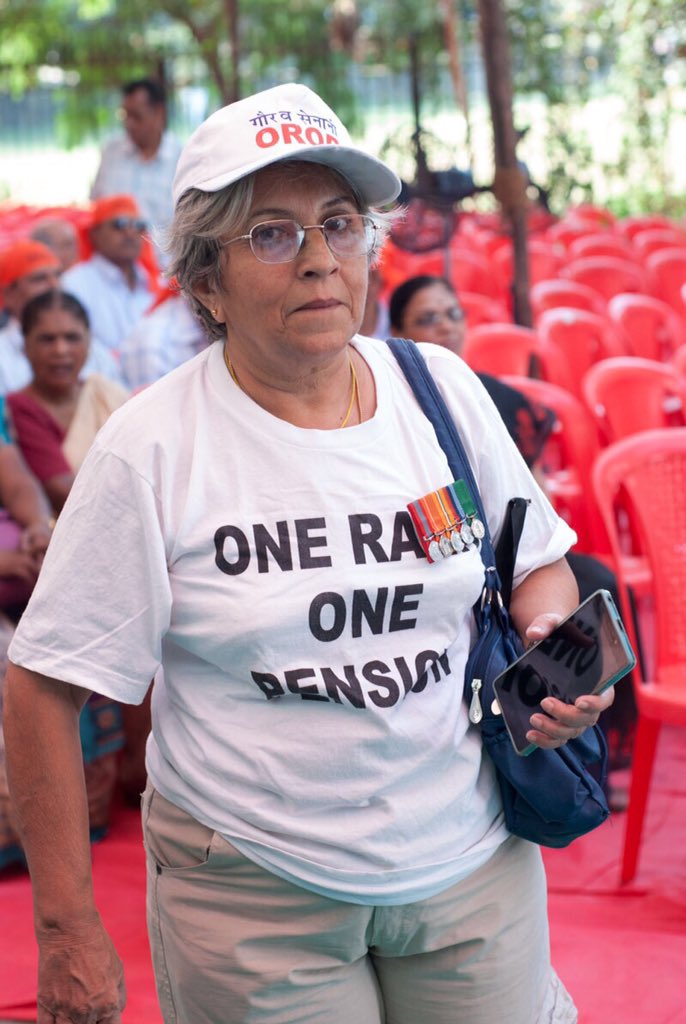
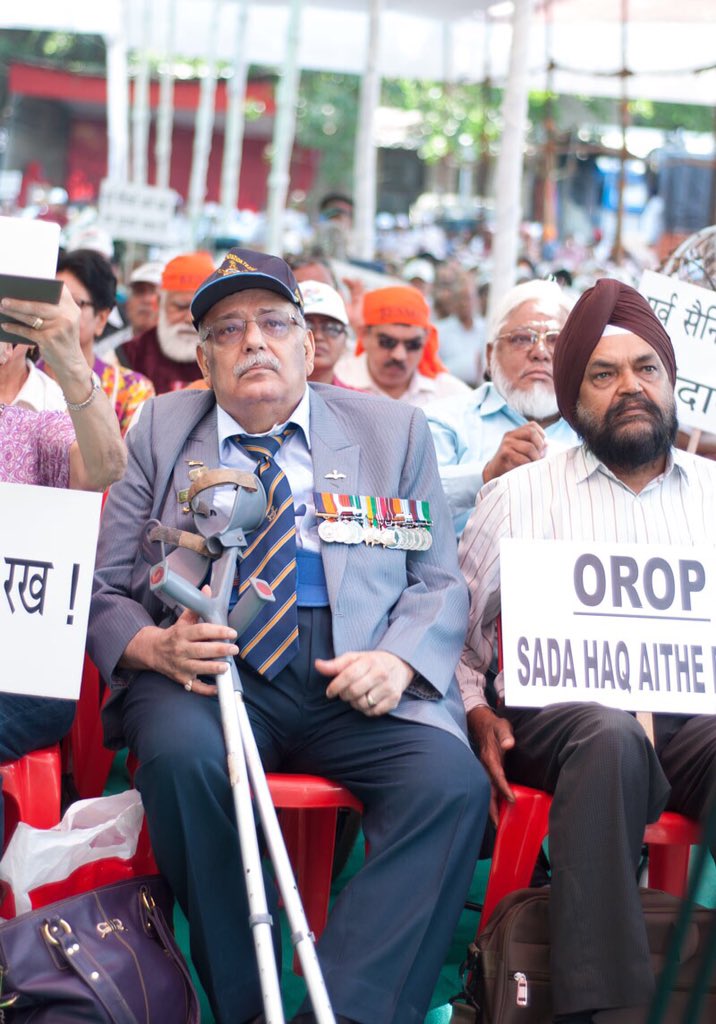
 One Rank One Pension
One Rank One Pension  Priyadarshi
Priyadarshi  Jo
Jo 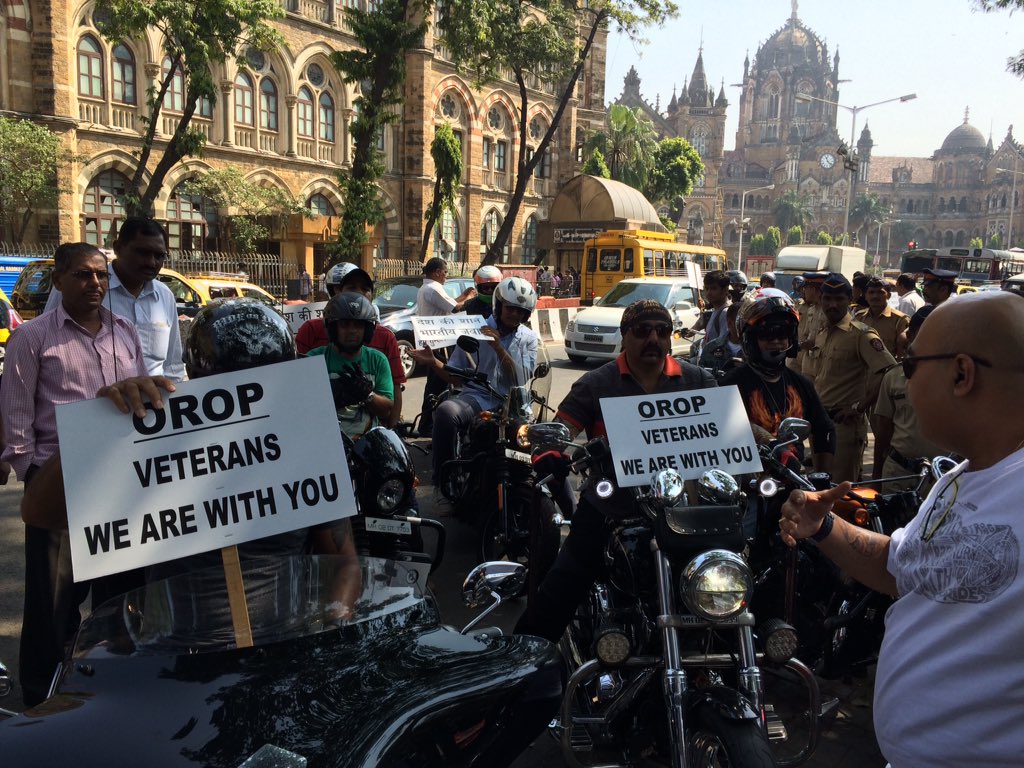
 Maj Gen Satbir Singh
Maj Gen Satbir Singh  Pravesh Renjen
Pravesh Renjen  Col Tekpal Singh(R)
Col Tekpal Singh(R)  Col Dinesh Kumar(R)
Col Dinesh Kumar(R)  Anil Kaul VrC
Anil Kaul VrC  Saurabh Patnaik
Saurabh Patnaik  Infidel Castro
Infidel Castro  S Arun
S Arun  Shuchi Singh Kalra
Shuchi Singh Kalra  Satpal sharma insa
Satpal sharma insa  Shivani Garg
Shivani Garg  Prashant Sethi
Prashant Sethi  Ashwas Priyadarshan
Ashwas Priyadarshan 
